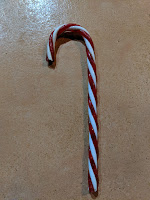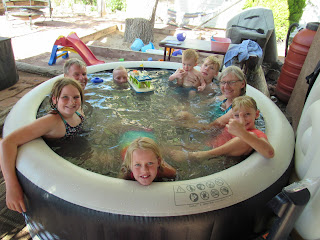"The virgin will conceive and give birth to a son, and they will call him Immanuel" (which means "God with us"). (Isaiah 7:14)
What can we learn today from a Jesus known as Immanuel? What can be said of a God who wants to be with us, and chooses to be with us in the form of a baby?
As Immanuel, God models an upside-down kingdom. We’ve heard the Christmas story so many times, we forget how crazy it is. So absolutely crazy. Our most powerful, almighty God had the ability to come to us as an earthly king, a celebrity, a learned scholar, a rich ruler--that would make sense to us in our human notion of power and leadership. Yet God chooses to reveal himself to us as a baby. And in the human form of Jesus, God wasn’t just a baby. He was a baby refugee. A baby refugee born into poverty. A racial minority refugee baby born into poverty. Completely defenseless, helpless, vulnerable. And this is what God chose.
When I was at the Tesoros de Dios party last week, looking around, I saw a number of children being held by parents. Kids--some babies, some teenagers--that cannot walk, talk, and do much of anything alone. Some that never will. They are defenseless, helpless, and vulnerable. And that, essentially, is how God chose to be when He came to us as a baby. That is how God chose to be.
 |
| Photo credit: Paola Rivas |
 |
| Photo credit: Paola Rivas |
I think one of the reasons I love working with kids with disabilities at NCA and at Tesoros de Dios is that I get glimpses of God as I serve those whom God chose to be like. When we think of becoming “Christlike,” are we picturing our brothers and sisters in Christ with significant disabilities? Yes, God is powerful and Jesus is King, but we’re also called to meet and love and know Jesus in his “Christmas form” as well. We meet God when we serve the vulnerable, the defenseless, the needy, the humble--the truly Christlike.
“For I was hungry and you gave me something to eat, I was thirsty and you gave me something to drink, I was a stranger and you invited me in, I needed clothes and you clothed me, I was sick and you looked after me, I was in prison and you came to visit me.’” (Matthew 25: 35-36)
As Immanuel, God models humility. God chose the humblest form in baby Jesus. In this act of “coming down,” I really can’t think of a better model of humility. And as Christ-followers, we’re called to be humble, too.
Finally, all of you, be like-minded, be sympathetic, love one another, be compassionate and humble. (1 Peter 3:8)
The work at Tesoros de Dios for our staff can be humbling. Laying on the floor with kids. Wiping noses. Getting hit or bit by a child with little impulse control. Shoveling literal tons of horse poop. Spending hours making 300 shish kabobs for the family Christmas party that will disappear in a matter of minutes once served. Dressing like a clown and dancing on a stage in front of hundreds of people laughing at you. But in baby Jesus, God shows us that life isn’t all about climbing up the ladder. God moved ALL the way down the ladder. Why? Love. Meeting us where we are, God’s beloved, broken people.
As Immanuel, God models the power of presence. In Spanish, the word “incarnation” is “encarnación,” with “carne” (which means flesh/meat) as the obvious root word. In Spanish, then, it is easy to see how this weighty term signifies God putting on flesh. God loved us so much that he sent part of himself to be WITH us as a human. God’s greatest gift in this act is truly his presence, and I believe that God is modeling something to us here. Our gift to others in our work and in our daily lives is our presence.
What does this look like? Doña Angela, the counselor at Tesoros de Dios, sitting with the moms for countless hours, hearing difficult story after story. Physical therapists spending time with those students in palliative care, kids bound by lifelong physical disabilities preventing what we’d note as “progress.” The Director, Michelle’s nightly devotions with the security guards. The staff of Tesoros de Dios are all in a ministry of presence.
I think so much about DOING. That is a problem I have as a gringo (according to my extensive cultural research:)). I’m seen at Tesoros de Dios most weeks driving up in my trusty Honda Odyssey and running around to meet with folks and paying payroll and checking things off my to-do list. No time for hanging out and relating beyond the “¿Cómo estás?” and “Bien, gracias.” Sometimes, it is easier for me to do than be. Through Immanuel, though, I’m reminded that God is in the business of BEING. What can a baby do? What can a baby offer? Only presence. Being with us.
As Immanuel, God brings people together. Both in the US and in Nicaragua, nothing brings people together like a baby. You can tell in any church when a new baby arrives for the first time; everyone huddles around to meet the new child. Baby Jesus brought people together, too. Think about the unlikely scene around the bed of Jesus, the baby bringing in shepherds from the fields, and much later wisemen from the East. And more people joined in the greeting of the newborn King as the years continued.
But the angel said to them, "Do not be afraid. I bring you good news that will cause great joy for all the people.” (Luke 2:10)
Jesus came for all people, that all people would be brought together around him in his life and death and resurrection. And Jesus is still bringing people together today. As I think about the ministry of Tesoros de Dios, I see a living example of Jesus bringing people together. It doesn’t make sense that hundreds of people in the United States and Canada would donate money each year to sustain this small, important ministry. It doesn’t make sense that the gringo volunteers at Tesoros de Dios have chosen a life so far from the comforts of home and blood family. It doesn’t make sense that 32 diverse Nicaraguan staff members come together each day to do difficult work at Tesoros de Dios. They could be searching for a higher paying job. They could let conflict rule, as they might have political differences or a difficult work history. And yet, they/we show up, together. Because besides the common work at Tesoros de Dios, they/we also share a common love for a baby born in Bethlehem. We’re all gathered as one diverse group around this baby Jesus even today.
 |
| Photo credit: Paola Rivas |
Immanuel--God with us. As we celebrate baby Jesus--God taking on flesh--remember the the upside-down kingdom, our call to humility and presence, and the gift of togetherness.
(This reflection is based on a devotional shared with the Tesoros de Dios staff at their end-of-the-year Christmas gathering)


























































